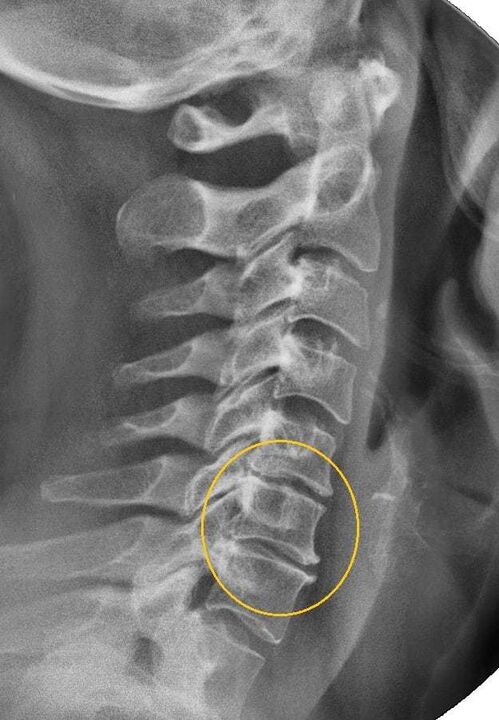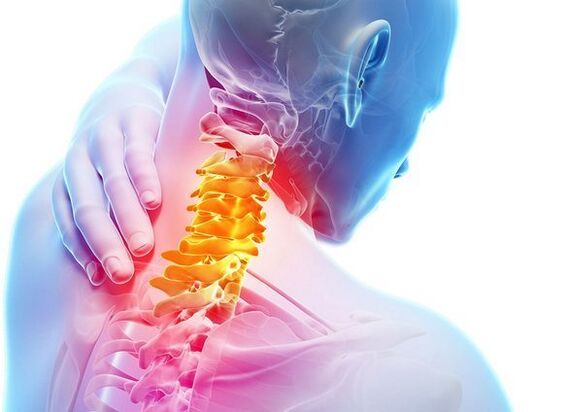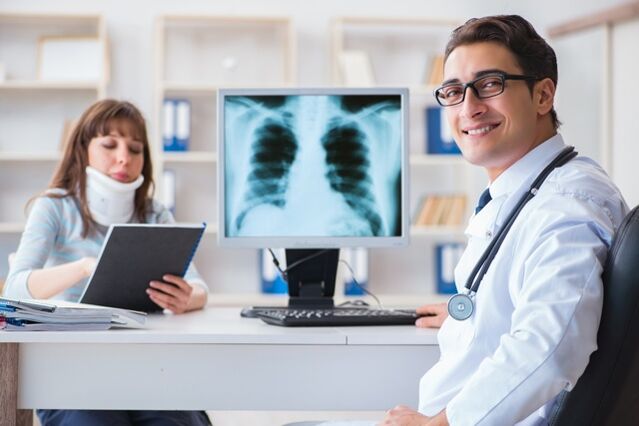Osteochondrosis is a common pathology of the spine, characterized by a dystrophic change in the structure of cartilage discs of the vertebrae and their bone.

To one degree or another, osteochondrosis occurs in most people after 30 years. The symptoms of cervical osteochondrosis are varied, which often complicates the diagnosis and subsequent treatment.
The causes of cervical osteochondrosis
In part in the development of osteochondrosis of the neck "guilty", the disorder of the modern man and the corresponding distribution of spinal stress, as well as the natural processes of aging of body tissues, in addition, there are a number of the development and progression of this pathology:
- A sedentary lifestyle;
- Long stay in the same position at work;
- excess body weight;
- continued injuries to the spine in the neck;
- chronic stress, constant nervous tension;
- Regular hypothermia of the muscles of the collar area (for example, when it is close to the air condition of the air conditioner);
- Congenital spinal abnormalities and intervertebral discs.
Common symptoms and signs of cervical osteochondrosis
The osteochondrus process affects one of the spine or several at a time. The lumbar and cervical vertebrae are most affected by pathologies, as most susceptible to load due to the anatomy of the human skeleton.
The effects of spinal osteochondrosis in the cervical region cause the most discomfort and potential complications, since the neck is a zone rich in neuromusive highways, many of which feed the brain directly.
For this reason, clinical symptoms with cervical osteochondrosis are very associated with ischemia of the brain areas. In addition, the nerve roots that ensure the sensitivity and motor activity of the hands and the shoulder girdle, when pressed with destroyed spinal animals, can give a variety of symptomatic picture.

The signs of osteochondrosis of the neck depend on which of the body systems are influenced by the pathology:
- Disconnected circulation due to compression of the spinal arteries determines most of the symptom complexes of the brain.
- The compression of the roots leaving vertebrates gives a picture of the lesion of the peripheral nerves.
- The pinching of the spinal cerebral areas is associated with severe neurological pathologies found in advanced cases.
Below, think about the General Osteochondrosis Clinic of the cervical spine.
Pain in the back of the head, neck and collar
This is the most common symptom. Pain localization can be extended, affecting the shoulders, the area of the clavicle, the chest, the conversion to an intense migraine of the head.
The nature of the pain depends on the location of the lesion and the severity of the pathology. At first, the pain can be quickly transient, gradually becoming chronic, sick.
At times of exacerbation, the pain becomes firing, with an increased tone of the neck muscles and limited movement of the head.
Often pain with cervical osteochondrosis can be localized behind the sternum, in which case many patients take this symptom of angina pectoris. Differentiation can be performed by taking a pill of nitroglycerin - pain due to osteochondrosis, they are not eliminated.
Noise, ringing, feeling of congestion in the ears
These symptoms often join the hearing reduction. These phenomena are associated with a decrease in blood flow from the spinal arteries to the vestibular apparatus.
The complex of these symptoms is called cochlear or snail syndrome and it is far from always possible to determine its relationship with osteochondrosis in the cervical region.
A specific characteristic of differentiation is that noise, congestion and ringing in the ears are felt when the position is changed, after a long stay in one position.
Dizziness
Dizziness is also due to a violation of blood flow to the organs of the inner ear, which guarantees the balance of the body. Nystagma often joins dizziness - arbitrary fluctuations in eye students to the countries.

Air
This sensation occurs due to irritation of the edges of the diaphragmatic nerve. It is a component of the cervical nerve beam and is involved in the regulation of breathing, its depth and frequency. Patients complain about the inability to breathe in the full breast.
In some cases, the symptom worsens to severe shortness of breath and suffocation. For the same reason, breathing stops at night and snore.
The disadvantage of oxygen due to breathing problems is ultimately the cause of increased fatigue, reducing concentration and memory problems.
Nausea
It is accompanied by landing. Also due to blood circulation problems in some areas of the brain and inner ear. Sometimes nausea is observed with unbreakable vomiting provoked by head and body movements. The consequence of frequent nausea and vomiting is a reduction in appetite, weight loss, valuable deficiency.
Vision problems
"Flies" in the eyes, reduction of visual acuity, fog in front of the eyes - these are all symptoms due to ischemia of the brain area responsible for vision.
Patients with osteochondrosis complain more than vision, as the lack of blood supply from the vertebrae is offset by the flow of blood from the carbon arteries system.
Glasses and therapeutic gymnastics for the eye muscles do not solve the problem, usually vision improves after the treatment of osteochondrosis.
Blood pressure advice
The unstable pressure level is due to impaired blood flow to the elongated brain, which is responsible for the functions of the vascular-motor center.
Sudden fainting or syncopal states
It occurs with spasm of the arteries of the brain due to the short -term stopping of the blood flow along the spinal arteries.
From the state of loss of the patient's consciousness, you can quickly remove it by placing it so that the legs are slightly higher than the head - blood flow to the brain allows a person to lead to life.
After a fainted attack, reversible problems with speech and movement due to a brief stop of blood flow, they can be observed for some time.

Green symptoms
Often this may be the only sign showing cervical osteochondrosis. They are expressed as sweating, dryness and a lump in the throat, difficulty in swallowing. The symptoms are related to the compression of the nerve plexus responsible for the innervation of the pharynx. It is necessary to distinguish similar manifestations from such a clinic for inflammation or neoplasms.
Fever
Increasing body temperature for cervical osteochondrosis is not the most typical symptom, it is rarely and locally observed: in the area of the cervix and collar with a slight redness of the skin.
The clinic of osteochondrosis in the cervical spine may be first of varying degrees of severity, it depends on the stage of development of pathology, also during periods of exacerbation, they are more bright and second, to form in certain syndromes.
Symptoms depending on the stage of cervical osteochondrosis
Stage I.
The beginning of degenerative processes in the cartilage of the vertebrae. The symptoms are weak, sometimes they cannot be observed at all. The first signs of osteochondrosis of the cervical spine:
- Discomfort in the neck, arms, shoulders, sometimes becomes pain;
- headache;
- Easy to limit the motor activity of the neck;
- fast passing visual damage;
- Reducing the sensitivity of the skin of the collar area.
Important: These symptoms become more pronounced when head tilted.
As a rule, in the first stage of osteochondrosis of the cervical region, patients do not go to the doctor, believing that all symptoms are associated with fatigue, stress, age, lack of sleep.
Stage II
At this stage, the bulge of vertebrates began, the intervertebral cracks were narrow, the collagen fiber of the fibrous ring of the disc was destroyed. There are noticeable painful symptoms of point nature due to the compression of the nerve trunks that increase during the movements of the neck and turns of the head. Here you can now suspect the cervical osteochondrosis, the symptoms of which in the second stage are as follows:
- a pronounced neck pain, sometimes with a crunch;
- The skin of the shoulders and hands loses the sensitivity almost completely;
- The headache is common, do not go for a long time;
- visual damage with "flies" in the eyes;
- ringing and tinnitus;
- weakness of the upper limbs muscles;
- The clarity of tendon reflexes is reduced;
- shooting pain with dedication under the shoulder blade;
- the feeling of a lump in the throat, problems with swallowing;
- Sleep disorders, usually insomnia.
Long holding of the head in one position leads to severe pain. At this stage of the development of the disease, patients already come to the doctor for help.
Stage III

The fibrous ring in the disc is destroyed, hernias are formed. In the third stage there is deformity of the spine, displacement and dislocations of the vertebrae due to their poor fixation. Symptoms are as follows:
- Intense, acute neck pain, collar area, heart area;
- The sensitivity of the scalp on the back of the head, in the area of the shoulder, in the hands, until the complete absence of;
- hernia of the cervical spine;
- Paresis and paralysis of the upper limbs;
- Tensile reflexes are practically not observed.
This is a severe stage of the disease in which the patient is no longer able to support his head alone. Ischemia of the spinal cord and compression of the arteries of the spine lead to paralysis and paresis in other parts of the body and spinal stroke.
Syndromes caused by osteochondrosis of the cervical spine
Non -specific and large number of different symptoms that accompany osteochondrosis of the cervical spine make it difficult to diagnose and further treat, as some of them may be a sign of completely different diseases. Symptoms of cervical osteochondrosis are formed in certain groups called syndromes. Their presence and weight can indicate pathology in the cervical spine with updated localization.
A group of common syndromes:
Korean. Otherwise, called cervical radiculitis. It combines the symptoms associated with impaired nerve roots of the cervical vertebrae. "Goosebumps" in the affected area, numbness of the fingers, forearms, shepherd's shepherd, spread in certain fingers, are characteristic.
Irritated-reflex. Burning and acute pain in the back of the head and neck, sometimes with the return to the chest and shoulder, which happens at the time of changing the position of the head and neck when sneezing, coughing and a sharp turn of the head.
Spinal artery syndrome includes:
- headache, attacks or constant, throbbing by nature;
- discomfort in some movements, including after a long static position;
- weakness, nausea, loss of consciousness;
- Hearing reduction, balance problems;
- Reduction of visual acuity.
Heart. Almost the same picture with angina often leads to improper diagnosis and treatment. The syndrome occurs due to irritation of the diaphragmatic nerve receptors, partially captivating the pericardium and a large pectoral muscle. Thus, the spasms in the heart area are more reflex, such as an examination of irritation of the cervical nerves. Symptoms:
- Suddenly, prolonged pain, increased with a sharp movement of the neck, coughing, sneezing, does not go away when taking cardiac drugs.
- The ECG does not indicate impaired blood flow to the heart muscle.
- Sometimes there may be extrasystole and tachycardia.
Vegetative-diabolic syndrome. Sulux the first vertebra of the cervical departure with displacement can lead to the development of vegeta-vascular dystonia. This is not a definite diagnosis of VVD as there are no symptoms pronounced.
There may be neurological signs, symptoms of impaired brain blood flow, intracranial pressure, muscle cramps.
As a result, the patient's complaints are reduced to dizziness, reduction of visual acuity, loss of consciousness, headache, nausea.
How to treat osteochondrosis of the uterus
The described condition of the spine is a very serious pathology, which with neglect leads to damage and as a result of deep disorders of cerebral circulation - and death. For this reason, by self -self, if such symptoms occur, you should not do.
Osteochondrosis is treated at a hospital and at home exclusively as a prescription.
In the initial stages, the treatment of osteochondrosis of the cervix is conservative, including medicinal recipes: non -steroidal anti -inflammatory drugs, anesthetics, hormonal drugs, vitamin complexes, chondroprotectors -all this relieves inflammation, pain, improves the trophy of soft heels and current curated.

In the acute period, the drugs are prescribed in the form of injections as the pain disappears, the patient goes to tablets. Physiotherapy, massage, exercise for exercise, usually prescribed at the remission stage, join the drug courses. In difficult cases, osteochondrosis is treated with surgery.
Prevention
The basis of the health of the cervical spine is a strong and healthy back, physical activity, a comfortable bed with anatomical pillows and a mattress, proper posture and proper nutrition.
It is worth avoiding neck injuries and weight lifting. It is necessary to combine prolonged sitting with rest and warm periods.
Recovery forecast
The prognosis for qualified and timely treatment is favorable, but a lot depends on the age of the patient, the severity of the manifestations and the stage of the disease. It is also important that the person performs medical recommendations on nutrition, lifestyle and elimination of bad habits.
Conclusion
Thus, in most cases, osteochondrosis of the cervical region can be cured. However, it is worth remembering that the disease can return at any time. In order to prevent this, it is necessary to monitor prevention and healthy lifestyle measures.
It is also worth remembering:
- The cause of osteochondrosis is difficult to establish.
- The symptom of the disease is pain in the back of the head and neck.
- Cervical osteochondrosis is treated comprehensively: medicines (mainly NSAIDs), massages, exercise therapy.























